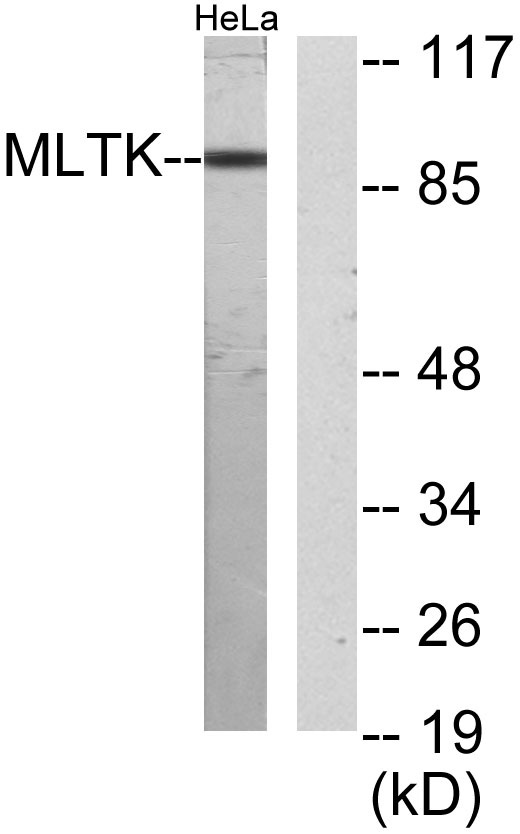MLTK Polyclonal Antibody
- Catalog No.:YT2790
- Applications:WB;IHC
- Reactivity:Human;Mouse
- Target:
- MLTK
- Fields:
- >>MAPK signaling pathway
- Gene Name:
- MLTK
- Protein Name:
- Mitogen-activated protein kinase kinase kinase MLT
- Human Gene Id:
- 51776
- Human Swiss Prot No:
- Q9NYL2
- Mouse Gene Id:
- 65964
- Mouse Swiss Prot No:
- Q9ESL4
- Immunogen:
- The antiserum was produced against synthesized peptide derived from human MLTK. AA range:701-750
- Specificity:
- MLTK Polyclonal Antibody detects endogenous levels of MLTK protein.
- Formulation:
- Liquid in PBS containing 50% glycerol, 0.5% BSA and 0.02% sodium azide.
- Source:
- Polyclonal, Rabbit,IgG
- Dilution:
- WB 1:500-2000;IHC 1:50-300
- Purification:
- The antibody was affinity-purified from rabbit antiserum by affinity-chromatography using epitope-specific immunogen.
- Concentration:
- 1 mg/ml
- Storage Stability:
- -15°C to -25°C/1 year(Do not lower than -25°C)
- Other Name:
- MLTK;ZAK;HCCS4;Mitogen-activated protein kinase kinase kinase MLT;Human cervical cancer suppressor gene 4 protein;HCCS-4;Leucine zipper- and sterile alpha motif-containing kinase;MLK-like mitogen-activated protein triple kinase;Mixe
- Observed Band(KD):
- 91kD
- Background:
- This gene is a member of the MAPKKK family of signal transduction molecules and encodes a protein with an N-terminal kinase catalytic domain, followed by a leucine zipper motif and a sterile-alpha motif (SAM). This magnesium-binding protein forms homodimers and is located in the cytoplasm. The protein mediates gamma radiation signaling leading to cell cycle arrest and activity of this protein plays a role in cell cycle checkpoint regulation in cells. The protein also has pro-apoptotic activity. Alternate transcriptional splice variants, encoding different isoforms, have been characterized. [provided by RefSeq, Jul 2008],
- Function:
- catalytic activity:ATP + a protein = ADP + a phosphoprotein.,cofactor:Magnesium.,enzyme regulation:Activated by phosphorylation by PKN1 and autophosphorylation on Thr-161 and Ser-165.,function:Stress-activated component of a protein kinase signal transduction cascade. Regulates the JNK and p38 pathways. Pro-apoptotic. Role in regulation of S and G2 cell cycle checkpoint by direct phosphorylation of CHEK2. Isoform 1, but not isoform 2, causes cell shrinkage and disruption of actin stress fibers. Isoform 1 may have role in neoplastic cell transformation and cancer development. Isoform 1, but not isoform 2, phosphorylates histone H3 at 'Ser-28'.,similarity:Belongs to the protein kinase superfamily. STE Ser/Thr protein kinase family. MAP kinase kinase kinase subfamily.,similarity:Contains 1 protein kinase domain.,similarity:Contains 1 SAM (sterile alpha motif) domain.,subcellular location:Tr
- Subcellular Location:
- Cytoplasm . Nucleus . Translocates to the nucleus upon ultraviolet B irradiation. .
- Expression:
- Ubiquitously expressed. Isoform 2 is the predominant form in all tissues examined, except for liver, in which isoform 1 is more highly expressed.
- June 19-2018
- WESTERN IMMUNOBLOTTING PROTOCOL
- June 19-2018
- IMMUNOHISTOCHEMISTRY-PARAFFIN PROTOCOL
- June 19-2018
- IMMUNOFLUORESCENCE PROTOCOL
- September 08-2020
- FLOW-CYTOMEYRT-PROTOCOL
- May 20-2022
- Cell-Based ELISA│解您多样本WB检测之困扰
- July 13-2018
- CELL-BASED-ELISA-PROTOCOL-FOR-ACETYL-PROTEIN
- July 13-2018
- CELL-BASED-ELISA-PROTOCOL-FOR-PHOSPHO-PROTEIN
- July 13-2018
- Antibody-FAQs
- Products Images

- Western Blot analysis of various cells using MLTK Polyclonal Antibody diluted at 1:1000

- Immunofluorescence analysis of HepG2 cells, using MLTK Antibody. The picture on the right is blocked with the synthesized peptide.

- Western blot analysis of lysates from HeLa cells, using MLTK Antibody. The lane on the right is blocked with the synthesized peptide.

- Immunohistochemical analysis of paraffin-embedded human Squamous cell carcinoma of lung. 1, Antibody was diluted at 1:200(4° overnight). 2, Tris-EDTA,pH9.0 was used for antigen retrieval. 3,Secondary antibody was diluted at 1:200(room temperature, 45min).



